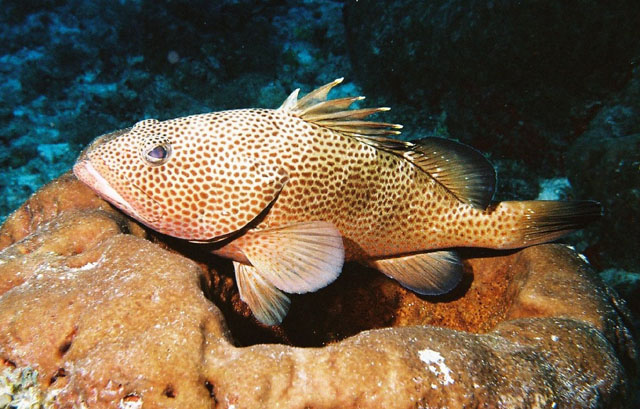| Epinephelidae (Groupers) |
| 76 cm TL (male/unsexed); max.weight: 25 kg; max. reported age: 22 years |
|
reef-associated; marine; depth range - 100 m, oceanodromous |
| Western Atlantic: North Carolina, USA to Paraíba, Brazil (Ref. 57756). The most common species of Epinephelus in the West Indies. |
|
Dorsal spines (total): 11-11; Dorsal soft rays (total): 15-16; Anal spines: 3-3; Anal soft rays: 8-8. Scales cycloid except for a ctenoid patch of variable size in the pectoral region. Greenish gray to light brown on the back grading to white ventrally, with numerous well-spaced dull orange-red to brown spots on the head, body and fins. Five faint diagonal bars formed by darker spots on the sides. No saddle-shaped blotch on caudal peduncle or along base of dorsal fin (Ref. 26938); further characterized by having body depth contained 2.7-3.1 times in standard length; head length 2.3-2.4 times in standard length; evenly serrate preopercle, without salient angle; posterior nostril larger than anterior nostril (Ref. 89707). |
| Found in shallow reefs and rocky bottoms. Usually solitary
and territorial. Feed mainly on crabs (Calapa and
Mithrax) and other crustaceans (alpheid shrimps and
scyllarid lobsters), fishes (labrids and haemulids), and
octopus. Some undergo sexual inversion at 28 cm TL; most
fish larger than 40 cm are males. Important in terms of
numbers caught and total weight of landings in the Caribbean.
Easily approached by divers (Ref. 9710). Hermaphrodite
species. Excellent food fish (Ref. 26938). Readily caught
on hook and line and easily speared (Ref. 13442). |
|
Least Concern (LC); Date assessed: 22 November 2016 Ref. (130435)
|
| reports of ciguatera poisoning |
Source and more info: www.fishbase.org. For personal, classroom, and other internal use only. Not for publication.

